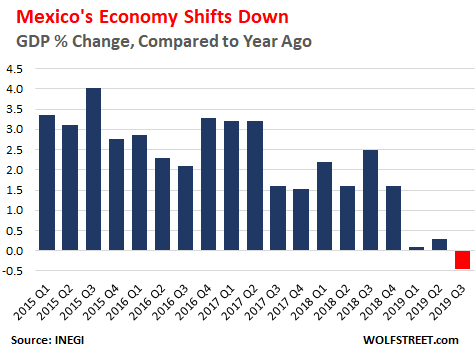Not just exports and manufacturing – but services stall.
By Nick Corbishley, for WOLF STREET:
In the third quarter of 2019, Mexico notched up its first year-over-year decline in GDP since the final quarter of 2009, when it was in the midst of a sharp recession brought on by the Financial Crisis. According to a preliminary estimate published by Mexico’s statistical institute INEGI, in the third quarter, the economy shrank 0.4% compared with the same quarter a year earlier.

On a quarter-to-quarter basis, GDP in Q3 ticked up a minuscule 0.1% from the weak second quarter (0% growth) after an even weaker first quarter that had booked a 0.3% decline. That tiny uptick in Q3 and the 0% growth in Q2, following the 0.3% decline in Q1, were enough to avert a “technical recession,” defined as two consecutive quarters of negative growth. But it wasn’t enough to pull GDP in Q3 up to where it had been last year — hence the first year-over-year decline since 2009.
Services, which account for 60% of Mexico’s GDP, stagnated with no growth on a quarter-by quarter or year-over-year basis.Manufacturing contracted by 0.1% quarter-by-quarter and 1.8% year-over-year. But agricultural production grew by 3.5% on a quarterly basis and by 5.3% year-over-year.
After successive quarters of managing to weather the storm generated by the U.S.-China trade war and the slowing global economy, exports in Mexico fell by 1.3% in September compared to a year earlier.
The worst affected sector was oil exports, where exports tumbled 29% year-on-year. But this is probably the result of President Andres Manuel Lopez Obrador’s strategy of refocusing Mexico’s state-owned, massively indebted oil behemoth Pemex’s output toward the domestic market as oil imports also fell year-on-year during the same month, by 17%.
For Pemex, the third quarter was a decidedly mixed one. On the negative side, it was blighted by the company’s fourth straight quarter of losses, totaling $4.6 billion. That stands in stark contrast to the $1.5 billion profit it registered in the same quarter of last year. On the positive side, Pemex’s crude production increased on the previous quarter by 1.2%, to 1.7 million daily barrels per day.
Growth in manufacturing exports is slowing to a crawl, up only 0.8% in September compared to a year ago, down from increases of 5.1% and 5.4% in July and August. Further compounding those concerns is the fact that imports of capital goods — goods that are used to produce other goods, which are then often exported — plunged by 13.5% in September, compared to a year earlier. According to Jonathan Heath, the deputy governor of the Bank of Mexico, this sharp fall in capital good imports is “the most disconcerting aspect of the September trade data.”
Another alarming trend is the dramatic slowdown of Mexico’s construction industry, which has notched up 10 straight months of declining output. In May, construction activity registered its biggest year-on-year fall (-10.3%) since records began, in 2006. Since then, the situation has continued to deteriorate. In August, the last month on record, year-on-year decline was 10.2%. This is happening due to two main reasons:
Private investors are afraid to invest. Since Mexico’s new government came into power in December, there has been greater enforcement of laws, rules and regulations concerning construction, which has made life more difficult for companies in the sector.
Public sector projects have ground to a virtual standstill. In the first half of 2019 Mexico’s government had invested just 20% of its projected budget for construction. This slowdown in public sector construction has been particularly pronounced in the capital, Mexico City, where almost 500 public and private development projects — over 40% of all the projects under way — have been halted or cancelled by the new city council.
Now, the declines in manufacturing and construction appear to have spread to the all-important services sector, which accounts for around 60% of Mexico’s GDP. In Q3 and Q2, the sector, which includes health services, financial services, transportation, education, and the like did not grow at all, following years of uninterrupted growth.
There are sharp differences among regions. According to the Mexican daily El Universal, 22 of the country’s 32 states already registered negative growth in Q2 of 2019. Eight of them (Sinaloa, Baja California Sur, Tabasco, Guerrero, Hidalgo, Chiapas and Michoacan) are apparently already in recession, having strung together two or more consecutive quarters of negative growth.
The disappointing economic data, the official inflation rate of 3% (lowest since 2016), and the Federal Reserve’s rate cut yesterday have intensified the pressure on the Bank of Mexico to slash its policy interest rate, which currently is at 7.5%, following two rate cuts over the summer. By Nick Corbishley, for WOLF STREET.
Mexican exports of new vehicles to countries other than the US have plunged, tripped up by the global auto slowdown. But some US automakers have shifted truck production to Mexico and have raised their imports from Mexico. Read… GM, Ford, BMW, VW, Honda Shift More Production to Mexico. Auto Imports Surge Despite Decline in US Sales